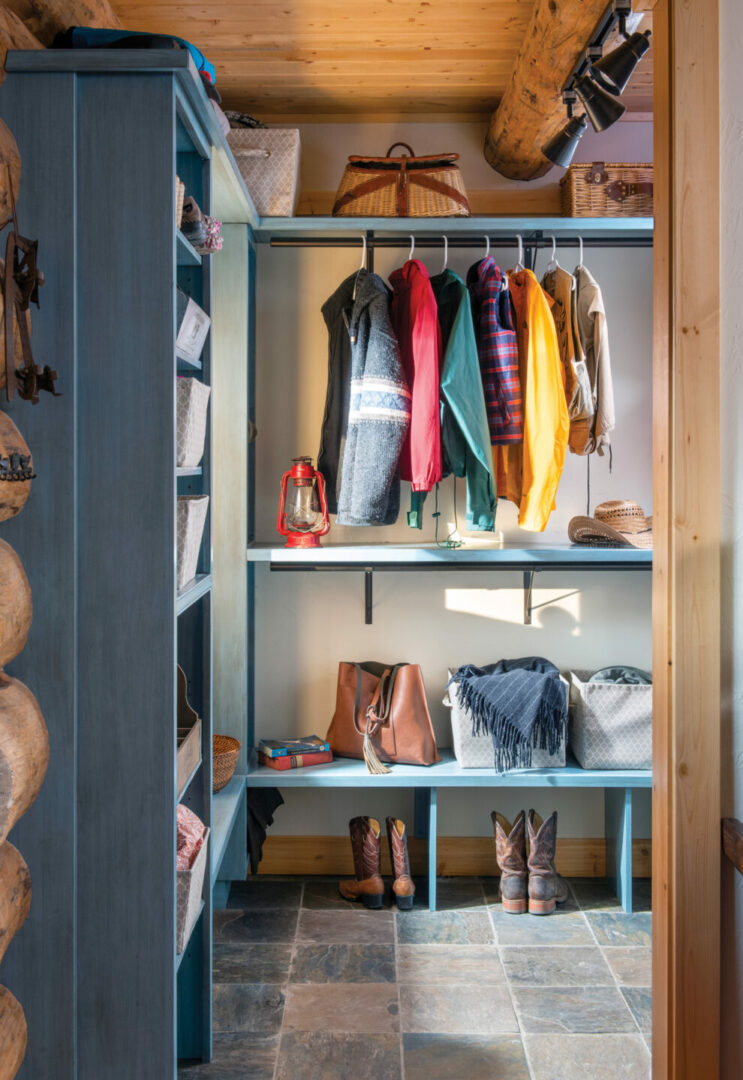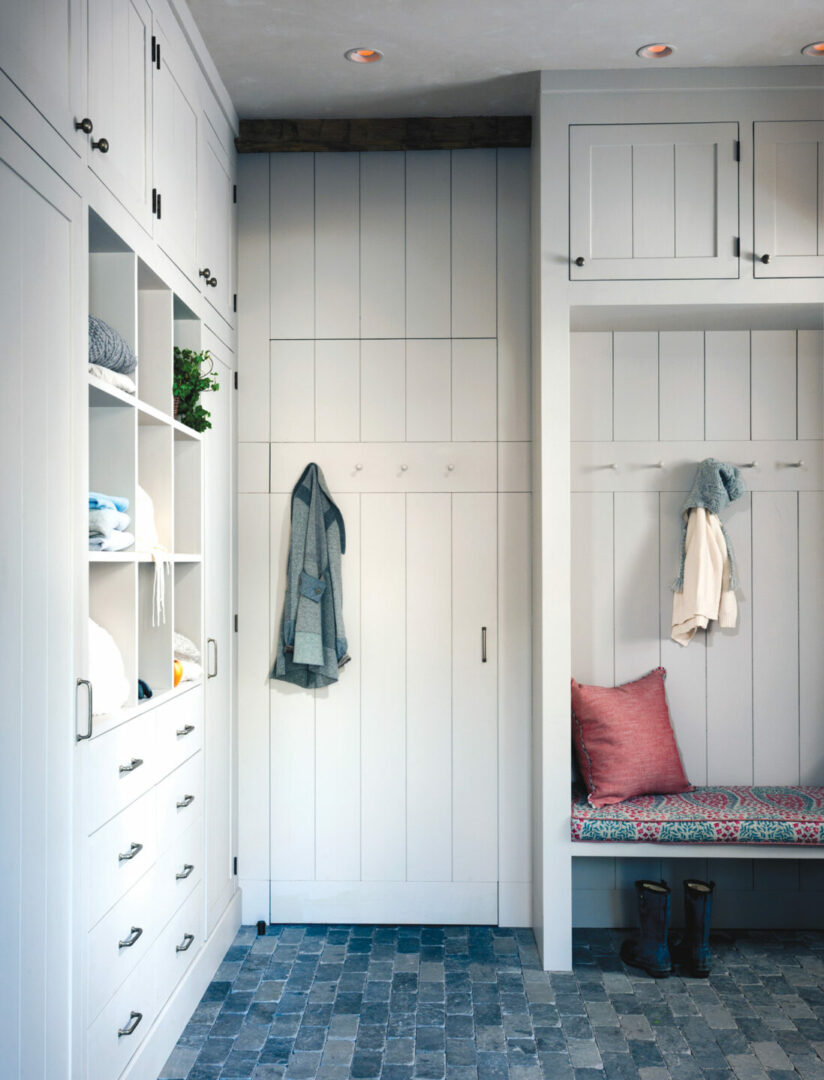Making the most of entryways and mudrooms adds convenience and style to a log or timber home.
Aside from the basic functions of ingress and egress, the look and feel of the entryway and the functionality of the mudroom add ambience and accessibility to the overall flow of a log or timber home floorplan.

As with any other visible aspect of the home, the entryway makes a statement, especially to first-time visitors. Any eye-catching accent or striking combination of wood tone and lighting create a memorable and pleasant experience with coming and going. Both exterior and interior preferences add to the ambience.
“Number one is the wow factor,” declared Jay Parmeter of Golden Eagle Log and Timber Homes. “When you approach the home and walk in the front door, it should create a lasting first impression. People should say, ‘Wow!’”
Brad Neu of Montana Log Homes added, “We’ve seen everything from simple to quite complex entryways. Folks need to consider available space and budget when designing their entries. Some smaller lots will make it difficult to add a nice portico, and some budgets will dictate how much can be apportioned to the entry.”
In every case, there is room for some style and personal expression. Consider preferences for double doors or a single large door. Will it contain any glass elements? If so, will they be clear or tinted, patterned or divided? Choosing something as simple as a decorative handle rather than a knob, along with appropriate hardware, can turn basic doorways into stylistic elements. Hardwood, LVT, stone and tile are options for the flooring, so which works better with the overall appeal of the home?
“Entryways are usually designed as welcoming spaces,” explained John Wallace, senior designer with MossCreek Designs. “Most are set up to have a wall area for decorative art or furniture. Decorative lighting is also a must and sets the stage for what lies beyond.”
According to Parmeter, one of the objectives of entryway design is to create a flow from the parking area to the front door. “In our model home, we have a pathway from where cars are parked that gradually rolls up to the home, and the trick is to make that rollup look natural, like part of the landscaping so that the walkway is gradual enough where it doesn’t appear to look like an afterthought.”
The beauty of the exterior of any log or timber home is enhanced with the proper style and execution of an entryway. Diana Schaeffer, office manager and sales assistant with Montana Log Homes, observed, “Entryways can add curb appeal to a design, breaking up the roof line or accenting the log with stone pillars or façade. It should be obvious to guests where they should approach the home. A great idea is having a porte-cochere or covered drive-through so that guests can stay out of inclement weather.”
Parmeter says that ceramic tile or hard surface stone are popular options for interior entryway flooring, particularly running six to eight feet from the door and then transitioning to hardwood or another type of flooring. “When you walk in, you usually look down for a split second, so good-looking flooring is a strong initial element. Then, the eyes come up and “Wow” comes in—high ceilings, big beams, a large stairway, big windows, and the stuff you see half a second after you’ve opened the door and made sure you won’t trip.”
Making the most of the mudroom adds more opportunity. Dressing up this entrance that owners and family members use often can provide real convenience along with a good-looking avenue of approach to the home.
“Floors and surfaces should be durable and easy to clean,” explained Schaeffer. “There should be ample storage for coats, hats, boots, and gear. An organized mudroom makes life smooth for on-the-go people. A utility sink or dog-wash station with a removable shower head is great, not only for muddy puppies, but also for rinsing mucky boots or dirty veggies from the garden. For cat people, the mudroom is a great place for the cat box that is hidden but not difficult to get to, and a bench or other seating is great for removing boots or snow gear.”
The mudroom is often located off the garage, and easy access may be most appreciated when bringing in armloads of groceries. “Consider how you live day to day,” remarked Wallace. “Even mundane daily tasks can be made more efficient by a hard-working mudroom. Also, consider how public or private the mudroom is from your guest’s eyes. This may help determine how decorative or how utilitarian it might look.”
Parmeter says that the mudroom entrance may be the primary one used by the homeowner, and with that in mind it makes sense to be able to kick off muddy shoes, drop heavy loads, or hustle the family dog inside. When these rooms are located off the garage, zero entry—without steps up and down—is a big plus, particularly to maintain footing with wet shoes or while carrying items.
“It really is remarkable how much easier it is to carry in groceries and make multiple trips when you don’t have to go up or down stairs,” noted Jay. “There’s a night-and-day difference, and having the mudroom close to the pantry and the kitchen makes putting those groceries away much easier, as well. Why carry them another 30 or 40 feet across the house?
“A hard-surface floor that is easy to clean is important too,” he continued. “Also, when you’ve come home from a long trip the first thing you might need is the bathroom, so some people like to build one immediately off the mudroom entry. Then there is the convenience of the laundry and placing the washing machine and dryer near the mudroom location, depending on how much room there is in the house. You’ll probably want to be able to throw dirty clothes in the washing machine right away.”
The inclusion of benches and storage in the mudroom is a major current trend, so consider adding seating and hooks, bins or cabinets to fully utilize the available space.
Creative mudrooms from MossCreek have included dog kennels tucked beneath countertops, hidden areas for dog bowls and litter boxes, and built-in recycling or waste bins. “We’ve even done multi-purpose office areas with mudrooms,” added Wallace.
Always think about the future when designing entryways or mudrooms. Wider doorways to accommodate baby strollers or wheelchairs help ease entry and exit during visits with grandchildren or when the owners are spending their golden years in the home they always wanted.
A bit of planning and a touch of creativity can turn an otherwise ordinary entryway or mudroom space into something that shows itself off and adds to the overall livability of a home.

